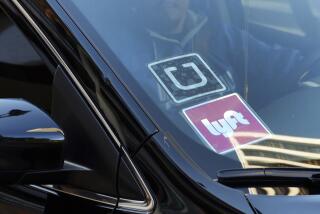Does Uber’s defeat in New York stem from Travis Kalanick’s choices or Dara Khosrowshahi’s?

Travis Kalanick loyalists experienced some serious schadenfreude this week when Uber Technologies Inc. lost a showdown with New York.
In 2015, Kalanick — Uber’s then-chief executive — scored his most pivotal policy victory in New York when the ride-hailing company faced down Mayor Bill de Blasio and won. Back then, Kalanick pulled out all the stops. The company launched an aggressive television ad campaign, held rallies with riders and drivers, and redesigned the Uber app to show a dystopian vision of New York without Uber (wait times: 25 minutes). Kalanick played a central role in that winning campaign, with the help of political fixer Bradley Tusk and the company’s New York general manager, Josh Mohrer. It was an overwhelming show of force. De Blasio backed down. Uber has increased its number of drivers about fourfold since then.
But the old wounds festered. Over the last two weeks, De Blasio supported a new, behind-the-scenes effort to cap the number of for-hire vehicles in his city at current levels. On Wednesday, the City Council passed that legislation and approved a minimum hourly wage for Uber drivers. It was a major defeat for Uber in one of its two most profitable markets (alongside London). Many inside the company believe that De Blasio’s animus toward Uber, above any particular policy consideration, drove the city to target for-hire vehicles as a way to quell traffic, rather than adopt congestion pricing.
As he did in London, where he scored a major victory, Uber’s current CEO — Dara Khosrowshahi, who took the reins last summer after Kalanick was ousted — met with local New York politicians to address concerns over cab driver suicides and heavy traffic. But while his cooperative approach worked across the pond, here at home it left Uber vulnerable. In the final days before the vote, Khosrowshahi stayed out of New York as his team sensed imminent defeat. Instead, he spent the week in Chicago and San Francisco.
“I think [legislative blowback] was almost inevitable once Uber switched CEOs. Dara was brought in to calm things down, avoid confrontation. In some ways that’s proven useful,” Tusk, a former advisor to Michael Bloomberg, said in a text message. “But when you’re in a tough situation like New York and you need to win a bare-knuckle fight, it’s no longer in their DNA to be able to take on or win these fights. They never really had a chance.”
Old-guard Uber folks are being even less generous off the record, sniping at Khosrowshahi and longtime Kalanick foe Jill Hazelbaker, the company’s senior vice president of communications and public policy. “They didn’t tell their story,” said one former Uber employee. “They got most of the newspapers aligned with them, but where was the heat? In 2015, they were doing press every day; they were screaming.” Another line of critique: Uber’s New York campaign focused largely on minority riders in the city’s outer boroughs, a retread of the same, now-stale campaign message it used three years ago.
But Kalanick’s critics inside Uber’s San Francisco offices see things very differently. In their view, the victory Kalanick and his henchmen scored in 2015 laid the groundwork for their defeat this go-round. And the scandals of 2017, starring Kalanick as their central figure, only further wrecked the company’s reputation with riders and drivers in New York.
So this year, when Uber had to try to persuade De Blasio and the City Council to back down, the company had few natural allies. One City Council member told a reporter that three years ago, Uber put out fliers that said she wanted to kill 10,000 jobs. “Uber lies. Uber really lies,” Councilwoman Karen Koslowitz said. She voted for the ride-hail cap.
Meanwhile, Uber drivers themselves supported restrictions on the number of cars allowed on the road. In 2015, drivers served as a powerful political tool in Uber’s pocket. It didn’t help that Uber cut fares at least twice in New York over the last three years as competition increased, antagonizing drivers. Uber riders also didn’t rally to the cause. Many customers now hold a negative view of the company they rely on to get around the city. And with so many cars on the road, nobody really felt worried they wouldn’t be able to hail an Uber. Three years after their all-out campaign, who was left to mobilize?
The stakes of Uber’s New York fight aren’t as high for the company as they were in 2015. The new restrictions could make it harder for upstarts to enter the market and compete with Uber. And it’s still not clear if the New York defeat will give smaller cities the courage to crack down on ride-hailing companies.
But the second-guessing over the New York defeat reflects the lingering tensions and strategic differences between Kalanick’s Uber and Khosrowshahi’s.
One current employee mused about the legacy of Kalanick’s 2015 victory, “It was called a scorched-earth campaign because the earth was scorched — and we paid for it.”






